1993 DODGE TRUCK air filter
[x] Cancel search: air filterPage 943 of 1502
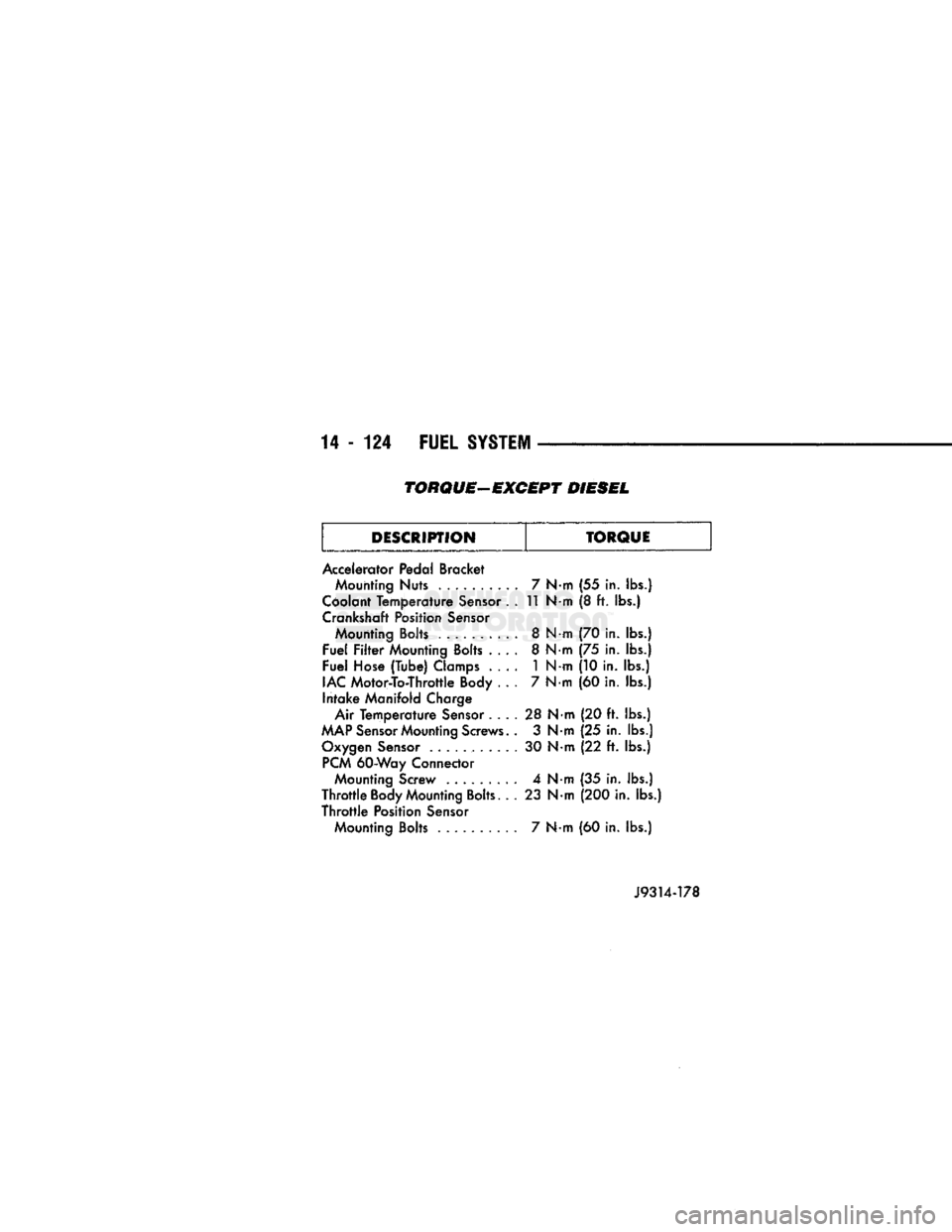
14-124
FUEL SYSTEM
TORQUE-EXCEPT DIESEL
DESCRIPTION TORQUE
Accelerator Pedal Bracket Mounting
Nuts
. 7
N
m
(55
in.
lbs.)
Coolant Temperature Sensor . . 11
N«
m (8 ft. lbs.)
Crankshaft Position Sensor Mounting Bolts . 8
N«
m
(70 in.
lbs.)
Fuel Filter Mounting Bolts . . . . 8
N-
m
(75
in.
lbs.)
Fuel Hose (Tube) Clamps . . . . 1
N-
m
(10 in.
lbs.)
IAC Motor-To-Throttle Body . . . 7
N-
m (60 in.
lbs.)
Intake Manifold Charge (60 in.
lbs.)
Air Temperature Sensor . . . . 28
N
•m
(20 ft.
lbs.)
MAP Sensor Mounting Screws. . 3
N
•m
(25
in.
lbs.)
Oxygen Sensor . 30
N
•m
(22
ft.
lbs.)
PCM 60-Way Connector Mounting Screw . 4
N
•m
(35 in.
lbs.)
Throttle Body Mounting Bolts. . . 23
N
•m (200 in. lbs.)
Throttle Position Sensor Mounting Bolts ......... . 7
N«
m
(60 in.
lbs.)
Page 944 of 1502
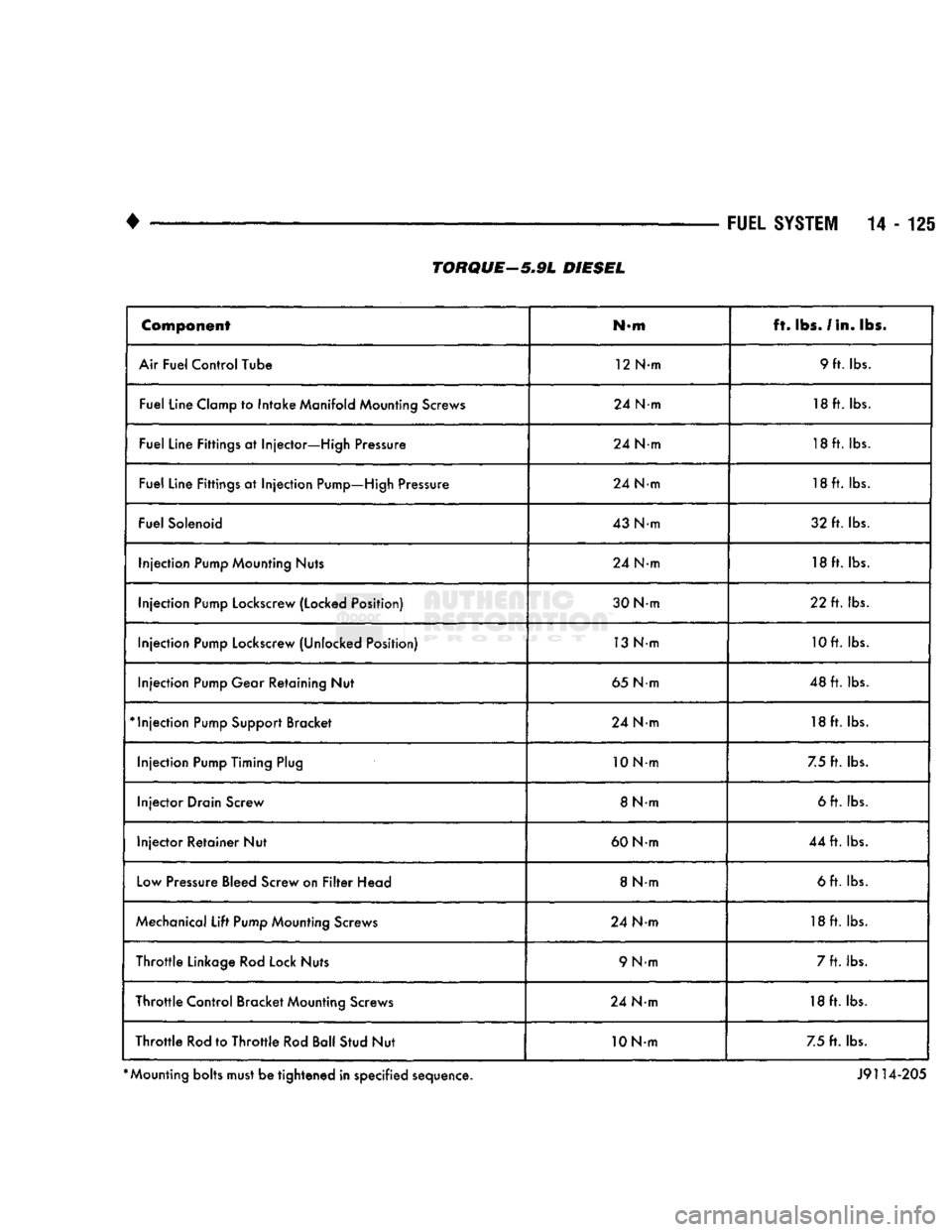
• —_ —_
FUEL
SYSTEM
14 - 125
Component
N-m ft.
lbs.
/In. lbs.
Air Fuel Control Tube 12 N-m 9 ft. lbs.
Fuel Line Clamp to Intake Manifold Mounting Screws 24 N-m 18 ft. lbs.
Fuel Line Fittings at Injector—High Pressure 24 N-m 18ft. lbs.
Fuel Line Fittings at Injection Pump—High Pressure 24 N-m 18ft. lbs.
Fuel Solenoid 43 Nm 32 ft. lbs.
Injection Pump Mounting Nuts 24 N-m 18ft. lbs.
Injection Pump Lockscrew (Locked Position) 30 Nm 22 ft. lbs.
Injection Pump Lockscrew (Unlocked Position) 13 Nm 10ft. lbs.
Injection Pump Gear Retaining Nut 65 Nm 48 ft. lbs.
*
Injection Pump Support Bracket 24 Nm 18 ft. lbs.
Injection Pump Timing Plug 10Nm
7.5 ft. lbs.
Injector Drain Screw 8 N-m 6 ft. lbs.
Injector Retainer Nut 60 Nm 44 ft. lbs.
Low Pressure Bleed Screw on Filter Head 8 Nm 6 ft. lbs.
Mechanical Lift Pump Mounting Screws 24 Nm 18ft. lbs.
Throttle Linkage Rod Lock Nuts 9 N-m 7 ft. lbs.
Throttle Control Bracket Mounting Screws 24 Nm 18 ft. lbs.
Throttle Rod to Throttle Rod Ball Stud Nut 10 Nm 7.5 ft. lbs.
*
Mounting bolts must be tightened in specified sequence. J9114-205
TORQUE—5.9L
DIESEL
Page 1087 of 1502
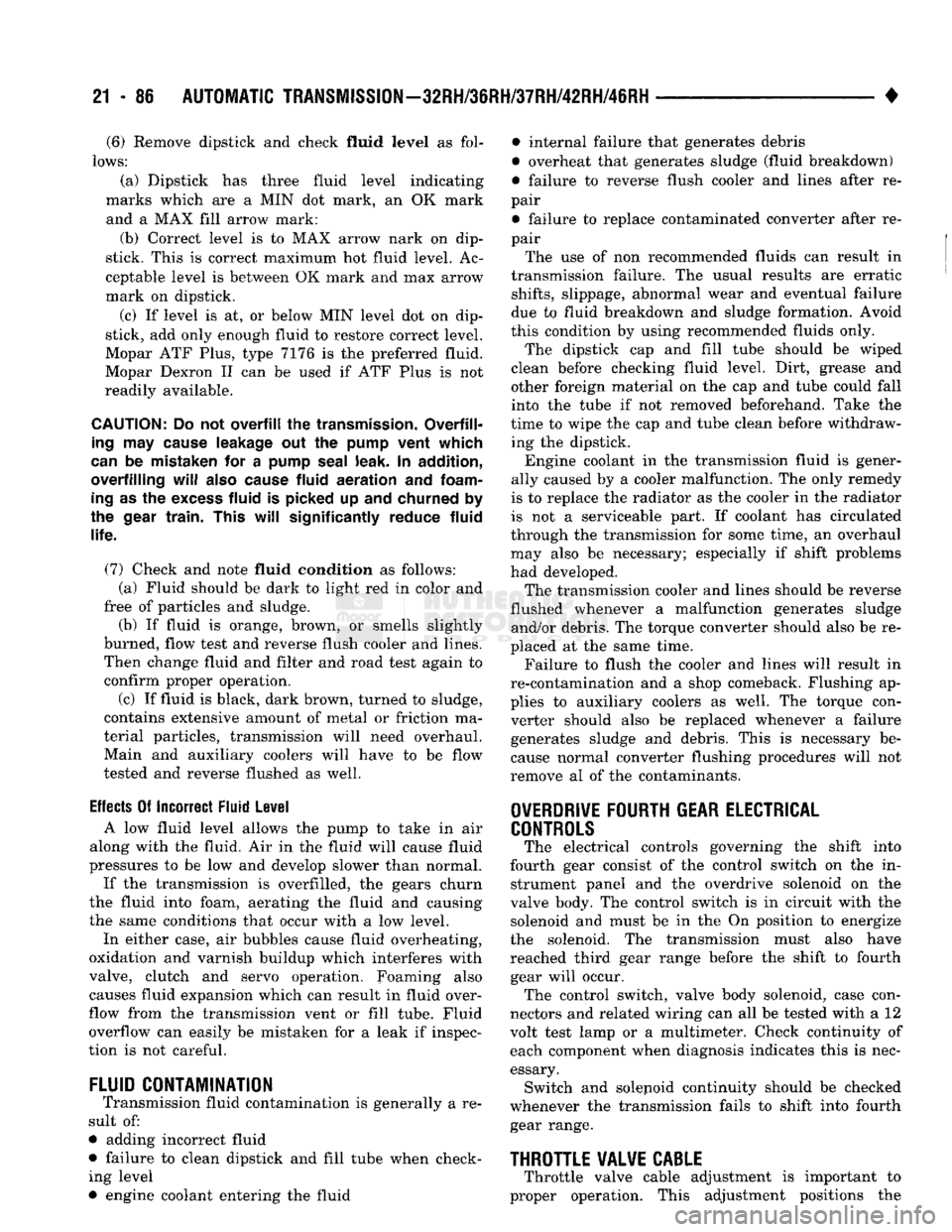
21 - 86
AUTOMATIC
TRANSMISSION-32RH/36RH/37RH/42RH/46RH
•
(6)
Remove dipstick and check fluid
level
as fol
lows:
(a) Dipstick has three fluid level indicating
marks which are a MIN dot mark, an OK mark and a MAX fill arrow mark:
(b) Correct level is to MAX arrow nark on dip
stick. This is correct maximum hot fluid level. Ac
ceptable level is between OK mark and max arrow
mark on dipstick.
(c) If level is at, or below MIN level dot on dip
stick, add only enough fluid to restore correct level.
Mopar ATF Plus, type 7176 is the preferred fluid.
Mopar Dexron II can be used if ATF Plus is not
readily available.
CAUTION:
Do not
overfill
the
transmission.
Overfill
ing
may
cause
leakage out the
pump
vent which
can
be mistaken for a
pump
seal
leak. In addition,
overfilling
will
also
cause
fluid
aeration
and
foam
ing
as the
excess
fluid is picked up and churned by
the
gear
train.
This
will
significantly
reduce fluid
life.
(7) Check and note fluid condition as follows: (a) Fluid should be dark to light red in color and
free of particles and sludge.
(b) If fluid is orange, brown, or smells slightly
burned, flow test and reverse flush cooler and lines. Then change fluid and filter and road test again to
confirm proper operation.
(c) If fluid is black, dark brown, turned to sludge,
contains extensive amount of metal or friction ma
terial particles, transmission will need overhaul. Main and auxiliary coolers will have to be flow
tested and reverse flushed as well.
Effects
Of Incorrect Fluid Level A low fluid level allows the pump to take in air
along with the fluid. Air in the fluid will cause fluid
pressures to be low and develop slower than normal.
If the transmission is overfilled, the gears churn
the fluid into foam, aerating the fluid and causing
the same conditions that occur with a low level.
In either case, air bubbles cause fluid overheating,
oxidation and varnish buildup which interferes with
valve, clutch and servo operation. Foaming also causes fluid expansion which can result in fluid over
flow from the transmission vent or fill tube. Fluid
overflow can easily be mistaken for a leak if inspec
tion is not careful.
FLUID
CONTAMINATION
Transmission fluid contamination is generally a re
sult of:
• adding incorrect fluid
• failure to clean dipstick and fill tube when check ing level
• engine coolant entering the fluid • internal failure that generates debris
• overheat that generates sludge (fluid breakdown)
• failure to reverse flush cooler and lines after re
pair
• failure to replace contaminated converter after re
pair
The use of non recommended fluids can result in
transmission failure. The usual results are erratic
shifts,
slippage, abnormal wear and eventual failure
due to fluid breakdown and sludge formation. Avoid
this condition by using recommended fluids only.
The dipstick cap and fill tube should be wiped
clean before checking fluid level. Dirt, grease and
other foreign material on the cap and tube could fall
into the tube if not removed beforehand. Take the
time to wipe the cap and tube clean before withdraw ing the dipstick.
Engine coolant in the transmission fluid is gener
ally caused by a cooler malfunction. The only remedy
is to replace the radiator as the cooler in the radiator
is not a serviceable part. If coolant has circulated
through the transmission for some time, an overhaul may also be necessary; especially if shift problems
had developed.
The transmission cooler and lines should be reverse
flushed whenever a malfunction generates sludge and/or debris. The torque converter should also be re
placed at the same time.
Failure to flush the cooler and lines will result in
re-contamination and a shop comeback. Flushing ap
plies to auxiliary coolers as well. The torque con verter should also be replaced whenever a failure
generates sludge and debris. This is necessary be
cause normal converter flushing procedures will not
remove al of the contaminants.
OVERDRIVE
FOURTH
GEAR
ELECTRICAL
CONTROLS
The electrical controls governing the shift into
fourth gear consist of the control switch on the in strument panel and the overdrive solenoid on the
valve body. The control switch is in circuit with the solenoid and must be in the On position to energize
the solenoid. The transmission must also have
reached third gear range before the shift to fourth gear will occur. The control switch, valve body solenoid, case con
nectors and related wiring can all be tested with a 12
volt test lamp or a multimeter. Check continuity of each component when diagnosis indicates this is nec
essary. Switch and solejioid continuity should be checked
whenever the transmission fails to shift into fourth
gear range.
THROTTLE
VALVE
CABLE
Throttle valve cable adjustment is important to
proper operation. This adjustment positions the
Page 1092 of 1502
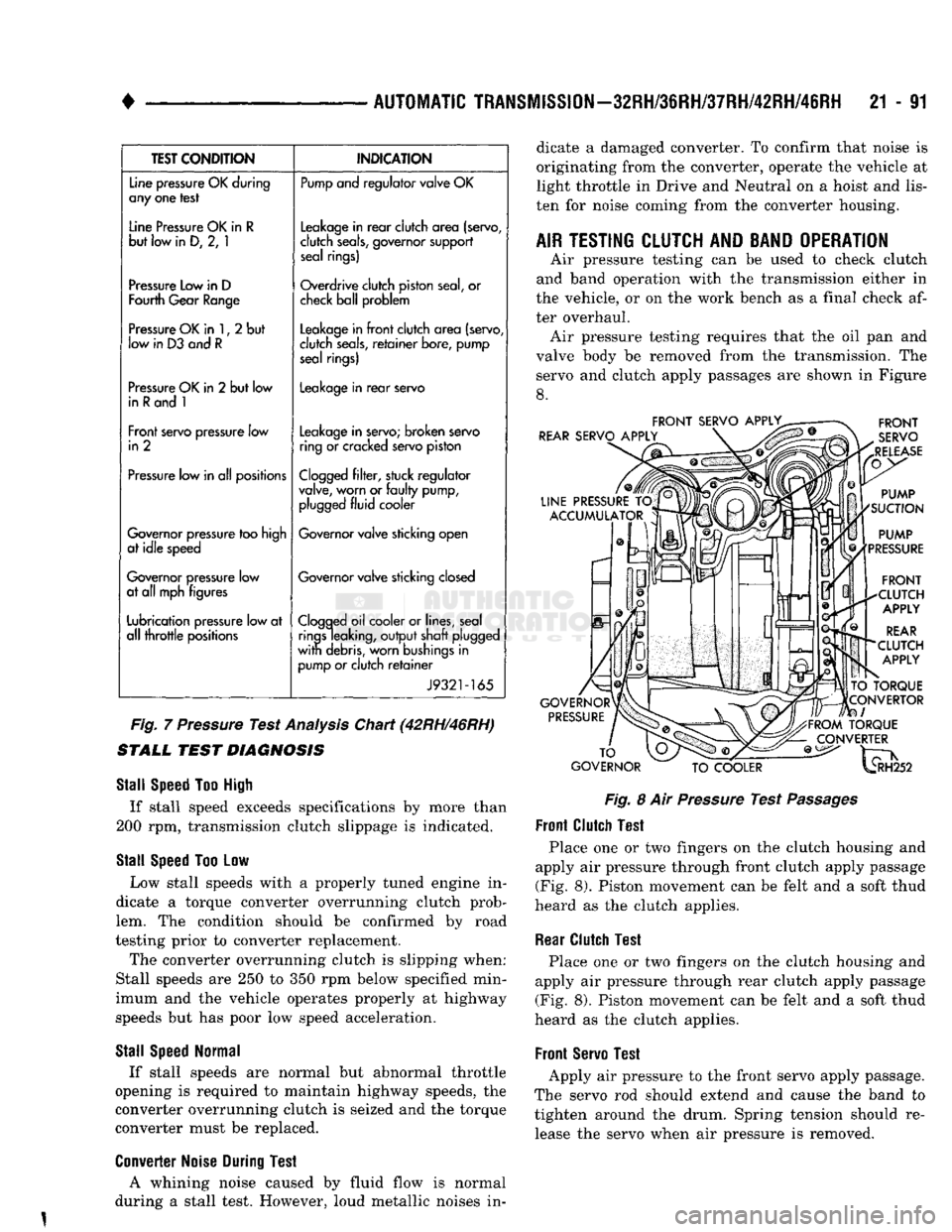
AUTOMATIC
TRANSMISSION—32RH/36RH/37RH/42RH/46RH
21 - 91
TEST
CONDITION
Line pressure OK during
any one test
Line Pressure OK in
R
but low in D, 2, 1
Pressure Low in D
Fourth Gear Range
Pressure OK in 1, 2 but
low
in
D3
and
R
Pressure OK in 2 but low in
R
and 1
Front servo pressure low
in 2
Pressure low in all positions
Governor pressure too high
at idle speed
Governor pressure low
at all mph figures Lubrication pressure low at
all throttle positions
INDICATION
Pump and regulator valve OK
Leakage in rear clutch area (servo,
clutch seals, governor support seal rings)
Overdrive clutch piston seal, or
check ball problem
Leakage in front clutch area (servo,
clutch seals, retainer bore, pump seal rings)
Leakage in rear servo
Leakage in servo; broken servo
ring or cracked servo piston
Clogged filter, stuck regulator
valve, worn or faulty pump, plugged fluid cooler
Governor valve sticking open
Governor valve sticking closed
Clogged oil cooler or lines, seal rings leaking, output shaft plugged
with debris, worn bushings in pump or clutch retainer
J9321-165
Fig.
7
Pressure
Test
Analysis
Chart (42RH/46RH)
STALL
TEST
DIAGNOSIS
Stall
Speed
Too
High
If stall speed exceeds specifications by more than
200 rpm, transmission clutch slippage is indicated.
Stall
Speed
Too Low Low stall speeds with a properly tuned engine in
dicate a torque converter overrunning clutch prob
lem. The condition should be confirmed by road
testing prior to converter replacement. The converter overrunning clutch is slipping when:
Stall speeds are 250 to 350 rpm below specified min
imum and the vehicle operates properly at highway
speeds but has poor low speed acceleration.
Stall
Speed
Normal
If stall speeds are normal but abnormal throttle
opening is required to maintain highway speeds, the
converter overrunning clutch is seized and the torque
converter must be replaced.
Converter
Noise
During
Test
A whining noise caused by fluid flow is normal
during a stall test. However, loud metallic noises in dicate a damaged converter. To confirm that noise is
originating from the converter, operate the vehicle at
light throttle in Drive and Neutral on a hoist and
lis
ten for noise coming from the converter housing.
AIR
TESTING
CLUTCH
AND
BAND
OPERATION
Air pressure testing can be used to check clutch
and band operation with the transmission either in
the vehicle, or on the work bench as a final check af
ter overhaul. Air pressure testing requires that the oil pan and
valve body be removed from the transmission. The servo and clutch apply passages are shown in Figure
8.
FRONT
SERVO
APPLY^
REAR
SERVO
APPLY
LINE
PRESSURE
TO
ACCUMULATOR
GOVERNOR
PRESSURE
FRONT
SERVO
RELEASE
PUMP
SUCTION
PUMP
PRESSURE
FRONT
CLUTCH
APPLY
REAR
CLUTCH
APPLY
TO
TORQUE
CONVERTOR
I
FROM
TORQUE
CONVERTER
TO
GOVERNOR
TO
COOLER
^H252
Fig.
8 Air
Pressure
Test
Passages
Front
Clutch
Test
Place one or two fingers on the clutch housing and
apply air pressure through front clutch apply passage (Fig. 8). Piston movement can be felt and a soft thud
heard as the clutch applies.
Rear
Clutch
Test
Place one or two fingers on the clutch housing and
apply air pressure through rear clutch apply passage
(Fig. 8). Piston movement can be felt and a soft thud
heard as the clutch applies.
Front
Servo
Test
Apply air pressure to the front servo apply passage.
The servo rod should extend and cause the band to
tighten around the drum. Spring tension should re lease the servo when air pressure is removed.
Page 1097 of 1502
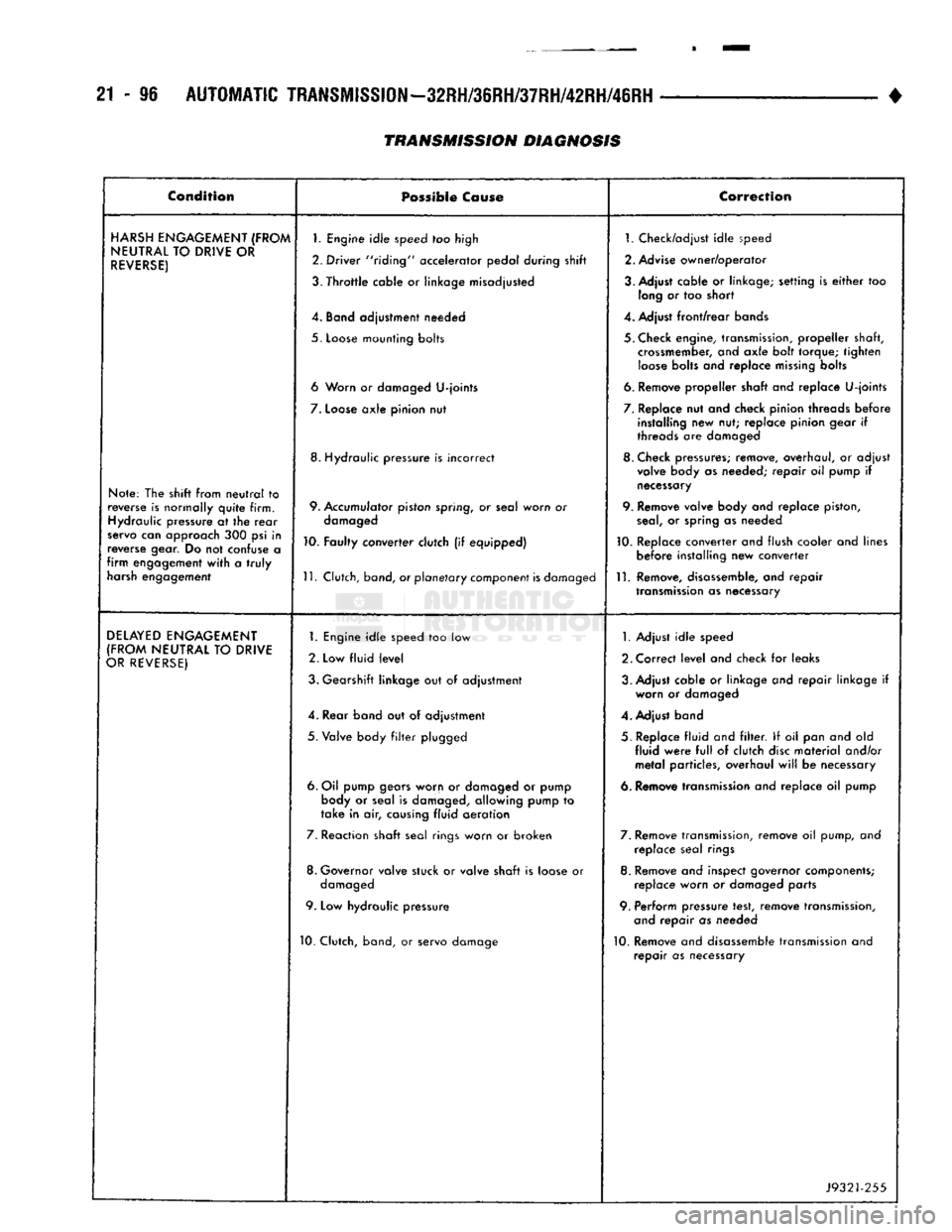
21 - 96
AUTOMATIC
TRANSMISSION—32RH/36RH/37RH/42RH/46RH
• Condition
Possible
Cause
Correction
HARSH
ENGAGEMENT
(FROM
NEUTRAL
TO
DRIVE
OR
REVERSE)
Note: The shift from
neutral
to
reverse is normally
quite
firm. Hydraulic pressure at the
rear
servo can approach 300 psi in
reverse gear. Do not confuse a
firm
engagement
with
a
truly
harsh engagement
1.
Engine
idle
speed too high
2. Driver "riding" accelerator pedal during shift
3.
Throttle
cable or linkage misadjusted
4. Band adjustment needed
5.
Loose
mounting bolts
6 Worn or damaged
U-joints
7.
Loose
axle
pinion nut
8. Hydraulic pressure is incorrect
9. Accumulator piston spring, or seal worn or damaged
10. Faulty converter clutch (if equipped)
11.
Clutch, band, or
planetary
component
is
damaged 1. Check/adjust
idle
speed
2. Advise owner/operator
3. Adjust cable or linkage; setting is
either
too long or too short
4. Adjust
front/rear
bands
5. Check engine, transmission,
propeller
shaft, crossmember, and
axle
bolt torque;
tighten
loose
bolts and replace
missing
bolts
6. Remove
propeller
shaft and replace
U-joints
7. Replace nut and check pinion threads
before
installing new nut; replace pinion gear if
threads are damaged
8. Check pressures; remove, overhaul, or adjust valve body as needed;
repair
oil pump if
necessary
9. Remove valve body and replace piston,
seal,
or spring as needed
10. Replace converter and flush cooler and lines
before
installing new converter
11.
Remove, disassemble, and
repair
transmission
as necessary
DELAYED
ENGAGEMENT
(FROM
NEUTRAL
TO
DRIVE
OR
REVERSE)
1.
Engine
idle
speed too low
2. Low
fluid
level
3. Gearshift linkage but of adjustment
4. Rear band out of adjustment
5.
Valve body
filter
plugged
6. Oil pump gears worn or damaged or pump body or seal is damaged, allowing pump to
take
in air, causing
fluid
aeration
7. Reaction shaft seal rings worn or broken
8. Governor valve stuck or valve shaft is loose or damaged
9. Low hydraulic pressure
10. Clutch, band, or servo damage
1.
Adjust
idle
speed
2. Correct
level
and check for leaks
3. Adjust cable or linkage and
repair
linkage if worn or damaged
4. Adjust band
5. Replace
fluid
and
filter.
If oil pan and old
fluid
were
full
of clutch
disc
material
and/or
metal
particles, overhaul
will
be necessary
6. Remove transmission and replace oil pump
7. Remove transmission, remove oil pump, and replace seal rings
8. Remove and inspect governor components; replace worn or damaged parts
9. Perform pressure test, remove transmission, and
repair
as needed
10. Remove and disassemble transmission and
repair
as necessary
J9321-255
TRANSMISSION DIAGNOSIS
Page 1098 of 1502
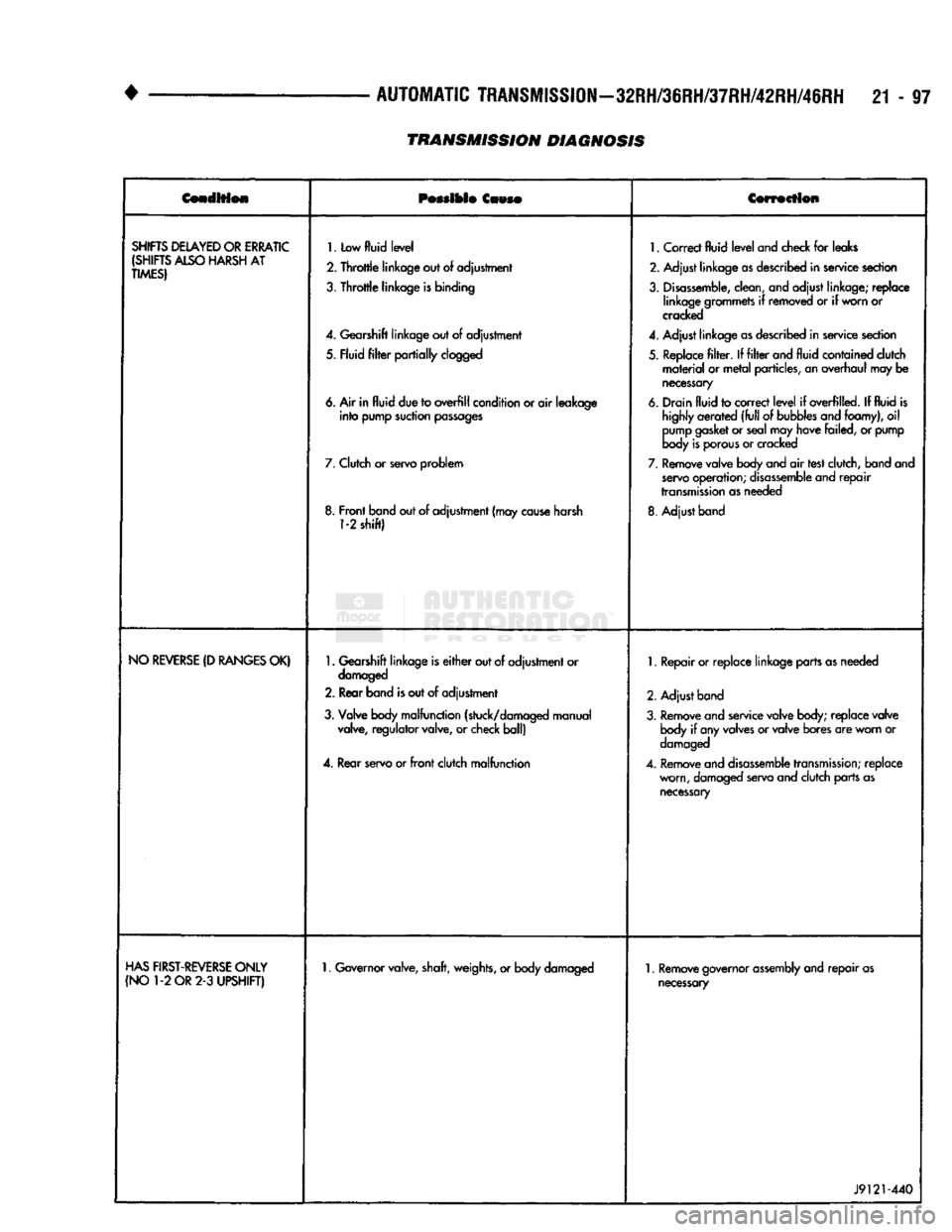
•
AUTOMATIC
TRANSMISSION—32RH/36RH/37RH/42RH/46RH
21 - 97
Cenoltfeie
Possible
Caws®
Cowscilon
SHIFTS
DELAYED
OR
ERRATIC
(SHIFTS
ALSO
HARSH
AT
TIMES)
1.
Low
fluid
level
2.
Throttle
linkage out
of
adjustment
3.
Throttle
linkage
is
binding
4.
Gearshift linkage out
of
adjustment
5. Fluid
filter
partially
clogged
6. Air in
fluid
due to
overfill
condition or
air
leakage
into
pump suction
passages
7.
Clutch
or
servo problem
8. Front band out of adjustment (may
cause
harsh
1-2
shift)
1.
Correct
fluid
level
and check
for
leaks
2. Adjust linkage
as
described in service section
3.
Disassemble,
clean, and adjust linkage; replace linkage grommets
if
removed
or if
worn or
cracked
4.
Adjust linkage
as
described in service section
5. Replace
filter. If filter
and
fluid
contained clutch
material
or
metal
particles, an overhaul may
be
necessary
6. Drain
fluid
to correct
level
if
overfilled.
If
fluid
is
highly
aerated
(full
of
bubbles
and foamy),
oil
pump
gasket
or seal may have failed,
or
pump
body
is
porous
or cracked
7.
Remove valve body and
air
test clutch, band and
servo
operation;
disassemble
and
repair
transmission
as needed
8. Adjust band
NO
REVERSE
(D
RANGES
OK)
1.
Gearshift linkage is
either
out of adjustment or
damaged
2. Rear band
is
out
of
adjustment
3. Valve body malfunction (stuck/damaged manual valve, regulator valve,
or
check ball)
4.
Rear servo or
front
clutch malfunction
1.
Repair or replace linkage parts as needed
2. Adjust band
3. Remove and service valve body; replace valve body
if
any valves or valve bores are worn
or
damaged
4.
Remove and
disassemble
transmission;
replace worn, damaged servo and clutch parts as
necessary
HAS
FIRST-REVERSE
ONLY
(NO
1-2
OR
2-3
UPSHIFT)
1.
Governor valve, shaft, weights, or body damaged
1.
Remove governor
assembly
and
repair
as
necessary
J9121-440
TRANSMISSION DIAGNOSIS
Page 1100 of 1502
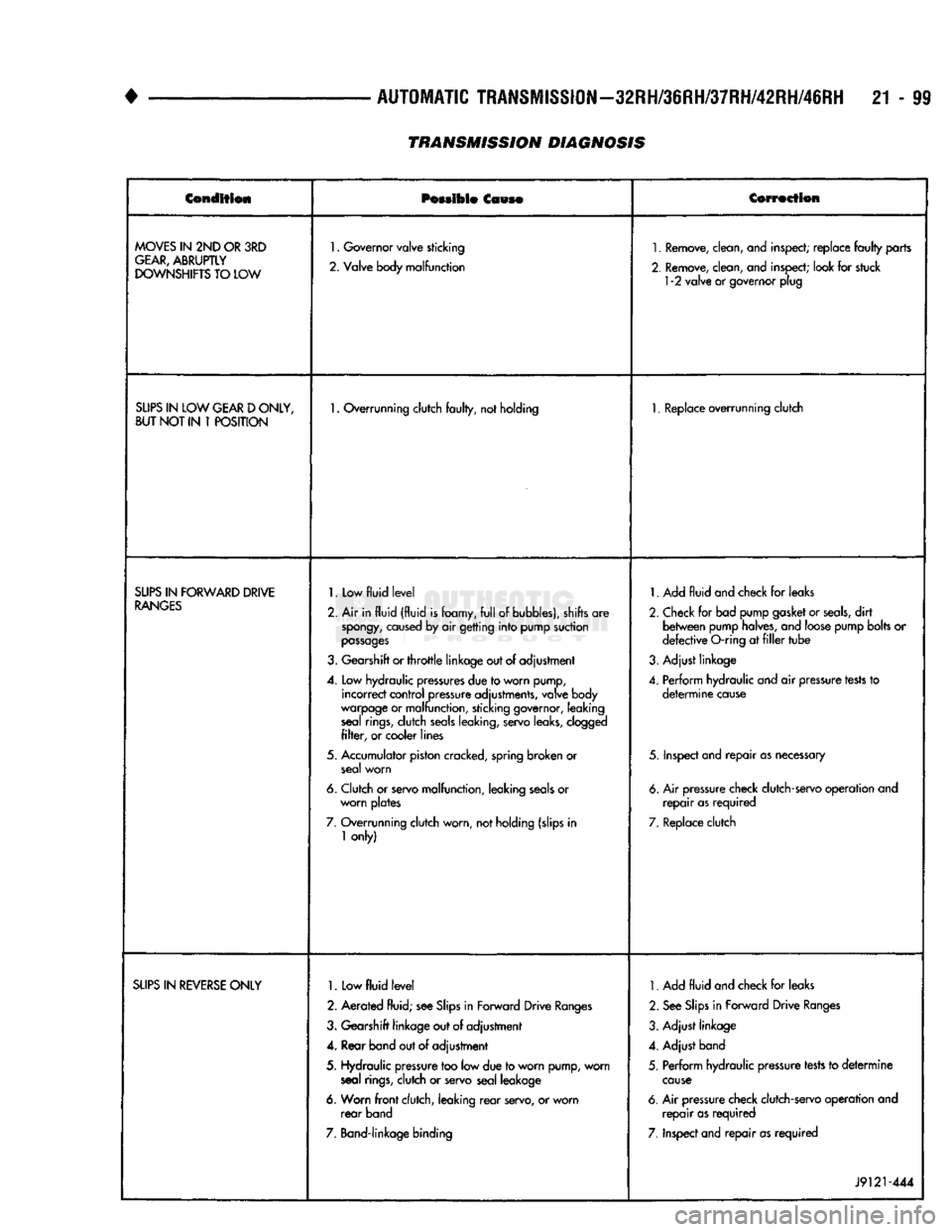
•
AUTOMATIC
TRANSMISSION-32RH/36RH/37RH/42RH/46RH
21 - 99 Condition
Possible
Cause
Correction
MOVES
IN 2ND OR 3RD
GEAR,
ABRUPTLY
DOWNSHIFTS
TO LOW
1.
Governor valve sticking
2. Valve body malfunction
1.
Remove, clean, and inspect; replace
faulty
parts
2. Remove, clean, and inspect; look for stuck
1
-2 valve or governor plug
SLIPS
IN LOW
GEAR
D
ONLY,
BUT
NOT IN 1
POSITION
1.
Overrunning clutch
faulty,
not holding
1.
Replace overrunning clutch
SLIPS
IN
FORWARD
DRIVE
RANGES
1.
Low
fluid
level
2. Air in
fluid
(fluid
is
foamy,
full
of bubbles), shifts are
spongy,
caused by air getting
into
pump suction
passages
3. Gearshift or
throttle
linkage out of adjustment
4. Low hydraulic
pressures
due to worn pump, incorrect control pressure adjustments, valve body
warpage or malfunction, sticking governor, leaking seal
rings,
dutch
seals
leaking, servo leaks, clogged
filter,
or cooler lines
5. Accumulator piston cracked, spring broken or seal worn
6. Clutch or servo malfunction, leaking
seals
or worn plates
7. Overrunning clutch worn, not holding (slips in
1
only)
1.
Add
fluid
and check for leaks
2. Check for bad pump gasket or
seals,
dirt
between
pump halves, and loose pump bolts or
defective
O-ring at
filler
tube
3. Adjust linkage
4. Perform hydraulic and air pressure
tests
to
determine
cause
5. Inspect and
repair
as
necessary
6. Air pressure check clutch-servo operation and
repair
as
required
7. Replace clutch
SLIPS
IN
REVERSE
ONLY
1.
Low
fluid
level
2. Aerated fluid; see
Slips
in Forward Drive
Ranges
3. Gearshift linkage out of adjustment
4. Rear band out of adjustment
5. Hydraulic pressure too low due to worn pump, worn seal
rings,
clutch or servo seal leakage
6. Worn
front
clutch, leaking
rear
servo, or worn
rear
band
7. Band-linkage binding
1.
Add
fluid
and check for leaks
2. See
Slips
in Forward Drive
Ranges
3. Adjust linkage
4. Adjust band
5. Perform hydraulic pressure tests to
determine
cause
6. Air pressure check clutch-servo operation and
repair
as
required
7. Inspect and
repair
as
required
J9121-444
TRANSMISSION DIAGNOSIS
Page 1103 of 1502
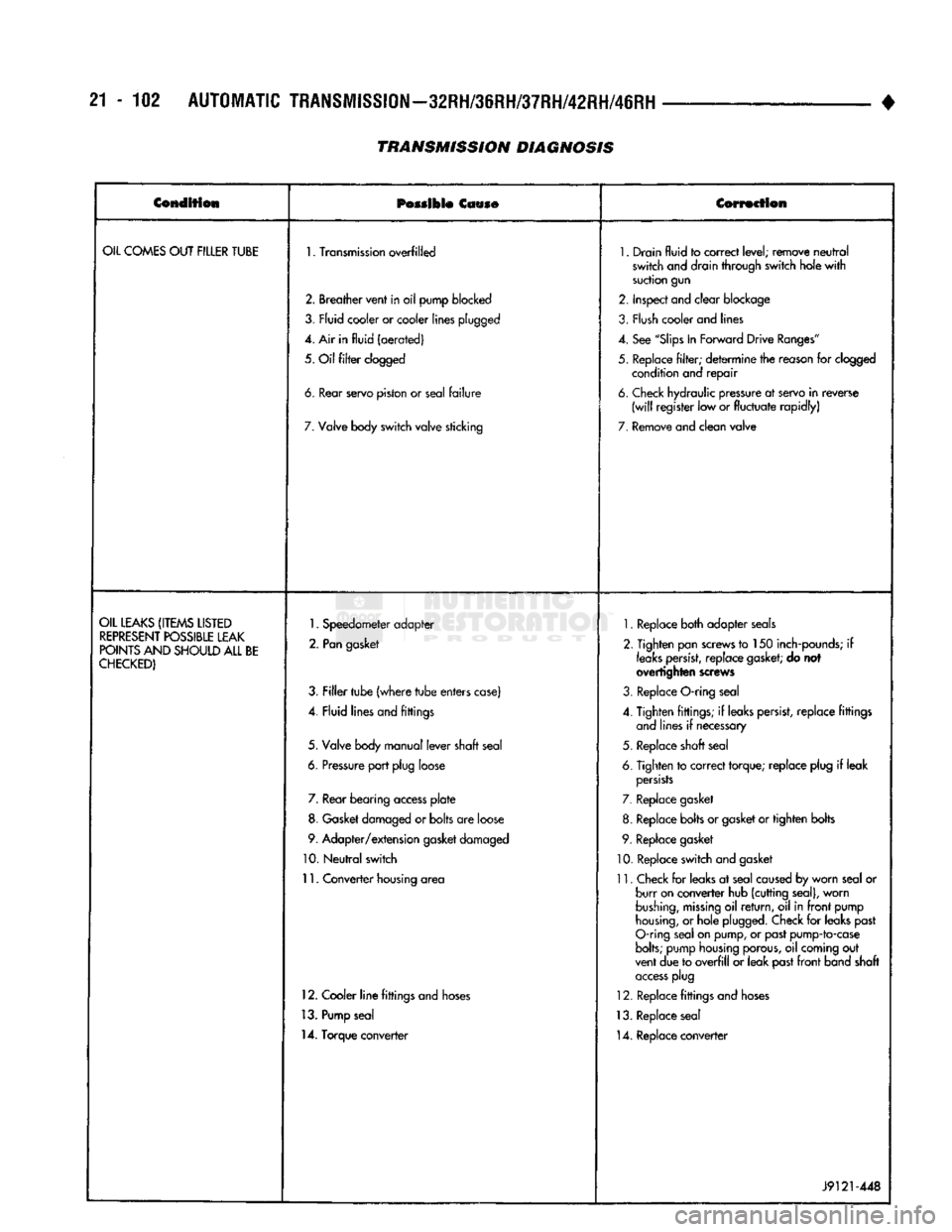
21-102
AUTOMATIC
TRANSMISSION—32RH/36RH/37RH/42RH/46RH
TRANSMISSION
DIAGNOSIS
•
Condition
Possible
Cause Correction
OIL
COMES
OUT
FILLER
TUBE
1.
Transmission
overfilled
1.
Drain
fluid
to
correct
level;
remove
neutral
switch
and drain
through
switch
hole
with
suction
gun
2.
Breather
vent
in
oil
pump
blocked
2.
Inspect
and
clear
blockage
3,
Fly id
cooler
or cooler
lines
plugged
3.
Flush
cooler and lines
4. Air in
fluid
(aerated)
4.
See
"Slips
In
Forward
Drive
Ranges"
5.
Oil
filter
clogged
5.
Replace
filter;
determine
the reason for clogged
condition and
repair
6.
tear
servo
piston
or
seal
failure
6.
Check hydraulic pressure at servo
in
reverse
(will
register
low or
fluctuate
rapidly)
7.
Valve body
switch
valve
sticking
7.
Remove
and
clean
valve
OIL
LEAKS
(ITEMS
LISTED
REPRESENT
POSSIBLE
LEAK
POINTS
AND
SHOULD
ALL
BE
CHECKED)
1.
Speedometer
adapter
2.
Pan
gasket
3.
Filler
tube
(where
tube
enters
case)
4.
Fluid
lines
and
fittings
5.
Valve body
manual
lever
shaft
seal
6.
Pressure
port
plug
loose 7. Rear
bearing
access
plate
8. Gasket damaged or
bolts
are loose
9.
Adapter/extension
gasket damaged
10.
Neutral
switch
11.
Converter
housing area
12. Cooler
line
fittings and hoses
13. Pump seal
14. Torque converter
1.
Replace both adapter seals
2. Tighten pan screws to 150 inch-pounds; if
leaks
persist,
replace
gasket;
do not
overtighten screws
3. Replace O-ring seal
4. Tighten fittings; if leaks persist, replace fittings and lines if necessary
5. Replace shaft seal
6. Tighten to correct torque; replace plug if leak
persists
7. Replace gasket
8. Replace bolts or gasket or tighten bolts
9. Replace gasket
10. Replace switch and gasket
11. Check for leaks at seal caused by worn seal or burr on converter hub (cutting seal), worn
bushing,
missing
oil
return,
oil in
front
pump
housing,
or hole plugged. Check for leaks past
O-ring seal on pump, or past pump-to-case
bolts;
pump housing porous, oil coming out
vent due to
overfill
or leak past
front
band shaft
access
plug
12. Replace fittings and hoses
13. Replace seal 14. Replace converter
J9121-448